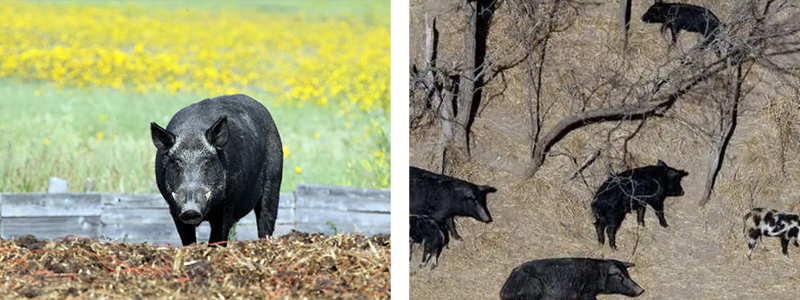A species of hybrid wild boar has seen a surge in its population in parts of Canada and the United States in recent times. They pose a serious threat to crops and livestock farms.
Recently, in the Canadian provinces of Alberta, Saskatchewan, Manitoba and other provinces, the number of hybrid wild boars known as "super pigs" has increased sharply. Not only do they damage crops and pollute water sources, they can also spread diseases such as African swine fever to pig farms, posing a threat to human health and safety.
.jpg)
Experts say that super pig sows can generally give birth to 6 piglets in a litter and can give birth to two litters a year, which means that even if more than 65% of super pigs are killed every year, their number will continue to increase.
Investigation shows that "super pigs" are distributed on both sides of the border between Canada and the United States. The U.S. Department of Agriculture is using aircraft and drones to increase monitoring of the northern border area, and state governments have also taken various measures, including setting up large ground traps, establishing tracking programs, and experts are researching pesticides for wild boar.
The origins of "Super Pig" can be traced back to the 1980s. At that time, Canadian farmers were encouraged to raise wild boars and crossbreed them with domestic pigs. But after entering the 21st century, the related market collapsed, and many farmers released the hybrid wild boar. Initially, many people thought that such a species could not survive the harsh Canadian winter, but in fact, the "super pig" had both the ability of wild boars to adapt to the wild environment and the high fecundity of domestic pigs, and it soon spread across Canada's southern provinces. More than 62,000 wild boar sightings have been recorded in Canada in recent years.

Recently, in the Canadian provinces of Alberta, Saskatchewan, Manitoba and other provinces, the number of hybrid wild boars known as "super pigs" has increased sharply. Not only do they damage crops and pollute water sources, they can also spread diseases such as African swine fever to pig farms, posing a threat to human health and safety.
.jpg)
Experts say that super pig sows can generally give birth to 6 piglets in a litter and can give birth to two litters a year, which means that even if more than 65% of super pigs are killed every year, their number will continue to increase.
Investigation shows that "super pigs" are distributed on both sides of the border between Canada and the United States. The U.S. Department of Agriculture is using aircraft and drones to increase monitoring of the northern border area, and state governments have also taken various measures, including setting up large ground traps, establishing tracking programs, and experts are researching pesticides for wild boar.
The origins of "Super Pig" can be traced back to the 1980s. At that time, Canadian farmers were encouraged to raise wild boars and crossbreed them with domestic pigs. But after entering the 21st century, the related market collapsed, and many farmers released the hybrid wild boar. Initially, many people thought that such a species could not survive the harsh Canadian winter, but in fact, the "super pig" had both the ability of wild boars to adapt to the wild environment and the high fecundity of domestic pigs, and it soon spread across Canada's southern provinces. More than 62,000 wild boar sightings have been recorded in Canada in recent years.


